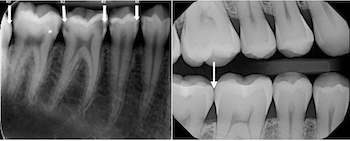Why do I need dental x-rays?
Dental x-rays help your dentist see underlying issue not obvious to the naked eye. The arrows show dental decay and the areas most commonly affected by dental decay.
Do you really need dental X-rays?
Dental decay can take 12-18 months to get to the stage where you need a filling. Regular X-rays help dentists pick up problems early and keep the solutions to these problems simple and small. That means less costly! Read on to find out how often you should be having X-rays of your mouth and teeth.
Why X-rays?
Decay occurs most commonly between the teeth, and you can’t see between the teeth. A visual exam is not enough and it is possible to miss the signs of early decay.The most common X-ray is the bitewing X-ray that focuses specifically on the areas between the teeth. This is the most common site for dental decay.
Other X-rays are used to examine the tooth root, or the jaw and supporting structures.
Who should have them?
Kids, on the other hand, have different oral care needs: They have thinner tooth enamel than adults, their jaws are still growing and their teeth are still developing. They may need more frequent X-rays than their parents, especially if they have a history of cavities and dental decay. If you miss a series of X-rays on a child with a high decay rate, you’re could end up with some serious problems.
How often should you have dental X-rays?
Are they safe?
In fact, not getting X-rays can be riskier. If your preschooler has a cavity, odds are high that there are several other unseen cavities between his or her teeth and you need an X-ray to track them down. If you’re pregnant and have a dental infection, failure to diagnose and treat it could be more dangerous for your baby than the X-ray itself.
Even though the level of radiation is low, precautions are taken to minimise your exposure. The X-ray machine focuses the radiation only on your mouth, and you can wear a lead apron and collar to protect other parts of your body. Your dentist and his or her staff have been thoroughly trained in taking X-rays, and the equipment itself is inspected regularly.
If your dentist recommends an X-ray of your mouth, feel assured it will safeguard your health, not threaten it.
“The benefit outweighs the low risk.”










